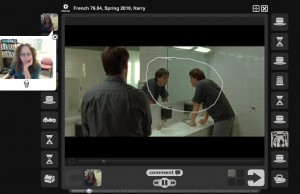Laura Florand, Lecturer, French Program, Romance Studies and
Brenna Heitzman, Graduate Student, French Program, Romance Studies and Women’s Studies Program
Laura Florand was one of fourteen faculty who, together with graduate student Brenna Heitzman, participated in a Spring 2010 CIT Fellowship for language faculty interested in exploring with colleagues the most effective and most efficient ways to increase students’ oral production in the target language, in order to increase students’ language learning.
Previous experience with out-of-class oral assignments, as well as current research on computer-mediated communication, had suggested to Florand and Heitzman that computer-mediated oral assignments could give voice to students who were relatively silent in the classroom, as well as pushing a higher level of discourse on the part of all students.
In addition, they felt that emphasis on student-to-student (as opposed to student-instructor) communication made assignments more meaningful. This could also mean that less of the “meaning” given to the assignment came from the grade it received or teacher feedback, which could lessen the overall responsibility on the part of the instructor for extensive and time-consuming feedback and assessment.
In their Fellowship experience, Florand and Heitzman aimed to design meaningful course assignments using VoiceThread, a tool which allows collaboration around images and other media, which would encourage student-to-student communication outside of their French 76 classroom. As a corollary, they planned to use student self-assessment to involve students in reflection on their oral progress, on strengths, weaknesses, and what they themselves can do to improve, thereby increasing student awareness of what different oral production assignments are accomplishing (and ideally increasing their meaning or value to students), and also increasing student self-efficacy.
Below, two sample screenshots show one of the class VoiceThreads.
Outcomes/Results:
- Their holistic grading rubric was designed based on their proposed approach and helped keep grading simple.
- Teacher prompts provoked meaningful connections between class themes and out-of-class oral production.
- Assignments clearly expressed students’ responsibility to communicate with and respond to each others’ contributions.
- The instructors observed students successfully communicating with each other and engaging in class themes. Students who were quite silent in the classroom often developed elaborate contributions via VoiceThread. Computer-mediated communication via VoiceThread effectively equalized participation.
- Sample surveys of students showed overall positive feedback to the technology and type of assignment and a desire to continue using it.
- “I noticed that I got much more comfortable talking/recording myself while using it”
- “Yes. It’s helpful to record French, but it’s better than simply recording. With VoiceThread, it’s more like presenting ideas rather than just speaking it.”
- “I wouldn’t say it increased my ability to have live conversation with my peers, but it did give me the opportunity to know their thoughts on subject matter when we weren’t in class.”
- “Listening to other peers’ comments helped me to further understand the prompt that was given. It also allowed me to communicate with them outside of the classroom.”
- “I am more comfortable with just expressing myself fluently without scripting what I am going to say.”
- “I guess it allows me to look at other students’ projects and comment on them. However, I did not really pay close attention to others’ work unless I was required to leave comments.”
- “Yes, because it provides an outlet from our own work space to speak French on a totally relaxed and individualized basis. If you mess up, you can re-record and there is no pressure.”
- “It is much better than Wimba because we had the opportunity to hear each other’s thoughts.”
- Overall, in response to this question, students repeatedly expressed a desire to use the technology more throughout the semester.
Best practices recommended by Florand and Heitzman:
- Design a clear and concise rubric. At their course level, they found a holistic rubric worked best. Grading can also be done on a check/check-plus basis, depending on the goals of the assignment.
- A clear, concise introduction to the technology helps establish student confidence from the beginning.
- Ask students to draw conclusions from the thread that they bring back into the classroom.
- Precise, instructor-generated prompts that are interesting and inspire meaningful discussion encourage more substantial discussion (while Florand and Heitzman did not experiment with student-initiated conversations, both noted it as an avenue to pursue.)
- It is important that computer-mediated communication serve as a prelude to face-to-face (classroom) discussion and not be a discrete and separate/final assignment.
Avenues to purse in the future:
They found that VoiceThread lends itself to a variety of methods to enhance student language production. Some ideas include:
- Interaction/ exchanges with students at universities in the U.S. and abroad
- Dubbing film clips (students working in groups and other students discuss & respond)
- Polling cultural reactions
- Student presentations on cultural topics
- VoiceThread journals
- Student-led discussions (students initiate and guide discussions as preparation for classroom presentations).


